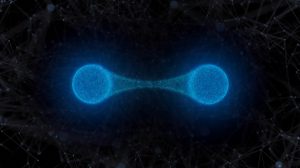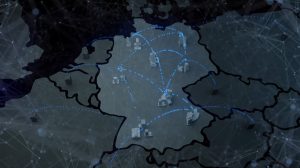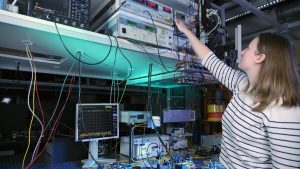BMBF initiative QuNET presents systems for highly secure quantum communication
An initiative of the Federal Ministry of Education and Research (BMBF) has been researching new possibilities for tap-proof communication for a year now. The ‘QuNET’ initiative is working on methods for exchanging information between authorities or in critical infrastructures – without third parties being able to eavesdrop. Today, Federal Research Minister Anja Karliczek and the participating research institutes presented the initial results. At a BMBF press conference, they presented the basics of the system architecture and systems for exchanging quantum keys over various distances.
Data security as the foundation of digital democracy
»Protecting the privacy of citizens in the digital world is a top priority for the German government. The security of data exchange is also of fundamental importance for the economy. This security can only be achieved in the long term with the help of quantum communication«, said Federal Research Minister Anja Karliczek at the press conference.
New types of quantum computers pose a threat to tap-proof and tamper-proof data transmission. They will be able to circumvent conventional encryption methods. The technologies of the future are already casting their shadows today: According to the motto ‘Store now, decrypt later’, data can already be stored today and read out later, with the help of more powerful computers or new algorithms.
New types of quantum computers pose a threat to tap-proof and tamper-proof data transmission. They will be able to circumvent conventional encryption methods. The technologies of the future are already casting their shadows today: According to the motto »Store now, decrypt later«, data can already be stored today and read out later, with the help of more powerful computers or new algorithms.
Novel quantum keys enable highly secure encryption
Against this backdrop, the BMBF’s QuNET initiative has been researching the potential of highly secure quantum communication for society and the economy since autumn 2019. The aim is to safeguard Germany’s national technological sovereignty as well as the security and confidentiality of data, even in the face of new communication technologies.
»My goal is to make Germany a world leader in the field of the ‘quantum internet’. Germany can become the European Union’s innovation driver in this field and take us a good step further on our path to technological sovereignty. QuNET is making an important contribution here. Already in the first year, the project developed technologies for a quantum-secured connection between two federal institutions«, said Federal Minister Anja Karliczek.
Over the past year, the research organisations involved in the project – the Max Planck Society, the Fraunhofer Society and the German Aerospace Centre – have jointly developed important foundations for modern and secure communication standards. The scientists looked at the overall architecture for systems for quantum-safe communication as well as the possibilities for exchanging quantum keys over long, medium and short distances using free-beam and fibre systems.
Four institutes contribute their expertise to research into quantum communication
Meanwhile, a team at the German Aerospace Centre (DLR) is researching systems that can transport quantum states over long distances. Aircraft or satellites are used for this, which can bridge large distances, for example within Germany or between different countries, using optical free-beam systems. »In QuNET, we are developing the necessary building blocks, core technologies and concepts for the overall system technology here at DLR«, explains Institute Director Christoph Günther.
The Fraunhofer-Gesellschaft develops technologies that enable quantum-based communication over short and medium distances, i.e. within a city or metropolitan region. Both free-beam and fibre systems are used for this purpose. »Fibre-based systems make it possible to integrate the latest quantum technology into existing communication networks, such as fibre optic cables«, explains Martin Schell, Director of the Fraunhofer Heinrich Hertz Institute HHI in Berlin. Free-beam systems, on the other hand, which are the focus of research at the Fraunhofer Institute for Applied Optics and Precision Engineering IOF in Jena, can realise short-term and mobile connections. Telescopes and light sources are being developed in Jena for this purpose.
Fraunhofer is also focussing on the development of interfaces between all these different subcomponents and their implementation in existing communication network infrastructures. »In this way, we are helping to promote a heterogeneous, hybrid communication network«, summarises Andreas Tünnermann, Institute Director of Fraunhofer IOF and spokesperson for the QuNET steering committee.
Advisory board from industry and the Federal Office for Safety support further development
In addition to the three leading research organisations, an advisory board consisting of experts from industrial companies in the fields of telecommunications, system and component development, security and the space industry as well as the Federal Office for Information Security are also involved in the QuNET initiative. The involvement of further partners, primarily from industry, is planned.
Facts and figures on the QuNET initiative
Start: Autumn 2019
Duration: 7 years
Funding organisation: Federal Ministry of Education and Research
Volume: 125 million euros in funding planned
The participating research institutes
The Fraunhofer Institute for Applied Optics and Precision Engineering IOF, based in Jena, conducts research into the further development of light as a means of solving a wide range of problems and application scenarios. The work of the research institute, which was founded in 1992, is therefore focussed on application-oriented research into light generation, light guidance and light measurement. Together with researchers from basic research and industry, innovative solutions are developed that provide a technological advantage in science and industry and open up new fields of application for photonics.
The Max Planck Institute for the Science of Light (MPL) covers a broad spectrum of research, including nonlinear optics, quantum optics, nanophotonics, photonic crystal fibres, optomechanics, quantum technologies, biophysics and – in collaboration with the Max Planck Centre for Physics and Medicine – connections between physics and medicine. The MPL was founded in January 2009 and is one of more than 80 institutes of the Max Planck Society that conduct basic research in the natural sciences, life sciences, humanities and social sciences in the service of the general public. Today, almost 250 people from around 30 nations work at the institute. Some of the researchers have decades of experience in the field of quantum communication. They also use telecoms technology for the exchange of quantum keys, which allows the processes to be used commercially quickly. For more than ten years, the Erlangen team has also been investigating how the keys can be transmitted over several kilometres on the ground using laser light (known as a free-beam connection) or over longer distances by satellite. The MPL is significantly involved in many large national and international projects – also in co-operation with national industry.
The DLR Institute of Communications and Navigation (IKN) is dedicated to mission-oriented research in selected areas of communications and navigation. Its work ranges from the theoretical foundations to the demonstration of new procedures and systems in a real environment and is embedded in the DLR programmes Space, Aeronautics, Transport, Digitalisation and Security. The institute currently employs around 190 people, including 150 scientists, at its sites in Oberpfaffenhofen and Neustrelitz. The institute develops solutions for the global networking of man and machine, for high-precision and reliable positioning for future navigation applications as well as processes for autonomous and cooperative systems in transport and exploration. The institute also deals with the security of radio systems. The focal points in this area include post-quantum cryptography and the transmission of quantum keys via satellite.
QuNET initiative: Questions and answers
Why this initiative?
Ever more powerful digital technologies are impacting today’s data networks and are increasingly jeopardising the security of this critical infrastructure of the modern information society. Added to this is the ongoing development of the quantum computer. The ability to calculate and analyse a multitude of possible options simultaneously not only creates new opportunities, but also risks. Many of the currently widely used core components of encryption, on which security is based, can be broken. Government organisations, the healthcare system and security-critical companies in particular must therefore rethink and renew their security infrastructures.
What is the aim of the initiative?
The primary goal of QuNET is to develop the physical and technical foundations as well as the necessary technologies for a tap-proof communication network using quantum physics. However, QuNET enables more than just secure communication: the prospective applications of the transmission of quantum states extend to networked quantum computers, the so-called quantum internet. This opens up completely new possibilities for materials science, in the financial sector or in the development of medicines.
How does quantum encryption work?
The goal is to make existing communication networks secure in the long term by means of a quantum key distribution (QKD). Quantum encryption takes advantage of the property of quantum particles that they cannot be measured or copied unnoticed. For example, a quantum source generates light pulses that are exchanged between two locations. From the results of a quantum mechanical measurement, a manipulation or a listening of the light pulses would be detected. Based on this, two keys can be generated, which are known only to the sender and receiver and which can be used for encryption. This method is also secure against all future attacks by a quantum computer. To overcome longer distances, satellites with quantum sources can generate the quantum keys over intercontinental distances, or else future developments of so-called quantum repeaters (cf. Q.Link.X) can be used.
What is the state of the art in quantum communication?
Quantum communication offers many potential applications for the benefit of the economy and society. Quantum key distribution (QKD) is probably one of the best-studied and most advanced examples internationally.





